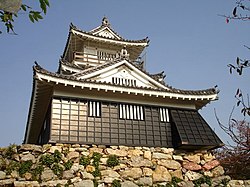| Hamamatsu Castle 浜松城 | |
|---|---|
| Hamamatsu, Shizuoka, Japan | |
 Keep of Hamamatsu Castle | |
| Coordinates | Coordinates: 34°42′42″N 137°43′30″E / 34.711802°N 137.724958°E |
| Type | Japanese castle |
| Height | three stories |
| Site information | |
| Condition | Reconstructed. Serves as a museum |
| Site history | |
| Built | Circa 1532, rebuilt 1958 |
| Built by | Imagawa clan |
| Materials | Wood, stone |
Hamamatsu Castle (浜松城 Hamamatsu-jō) is a reconstructed hirayama-style Japanese castle. It was the seat of various fudai daimyō who ruled over Hamamatsu Domain, Tōtōmi Province, in what is now central Hamamatsu, Shizuoka Prefecture, Japan.[1] It is also called Shussei Castle (出世城 Shussei-jō)
History[]
The origins of Hamamatsu castle are unclear; however, it appears that a fortification was built on this site by Imagawa Sadatsuke, the fourth head of the Enshū Imagawa clan from around 1504-1520. The early castle was called Hikuma Castle (引馬城 or曳馬城 Hikuma-jō) and was entrusted to Imagawa retainer Iio Noritsura. After the fall of Imagawa Yoshimoto at the 1560 Battle of Okehazama, Iio Tsuratatsu rebelled against Imagawa Ujinao, but was defeated. However, the greatly weakened Imagawa clan was unable to withstand the combined forces for Tokugawa Ieyasu from Mikawa and Takeda Shingen from Kai. The former Imagawa territories in Tōtōmi were divided between the Tokugawa and Takeda in 1568, with Tokugawa Ieyasu obtaining Hamamatsu. He relocated his headquarters from Okazaki Castle to Hamamatsu in 1570, and spent the following 17 years there.
Tokugawa Ieyasu renovated and greatly expanded the castle, which he renamed Hamamatsu Castle in 1577. He relocated to Sunpu Castle in 1586, entrusting Hamamatsu Castle to Horio Yoshiharu, who was followed by his son Horio Tadauji. After the Battle of Sekigahara, Hamamatsu was briefly ruled by Tokugawa Yorinobu, followed by a succession of fudai daimyō through the remainder of the Edo period. Contemporary records indicate that the castle was never built with a tenshukaku-style keep. Throughout its history, a two-story yagura located within the second bailey served as a substitute keep.
Statue of Tokugawa Ieyasu in the castle park
With the Meiji Restoration, the remaining military structures of the castle were destroyed, outer moats filled in, and outer baileys sold off. The central portion of the castle remained owned by the city as a park. In 1958, a faux donjon was constructed out of reinforced concrete on top of the original stone palisade built by Tokugawa Ieyasu. This palisade is known as the "Norzura-zumi", referring to the method used to fit the stones together. The reconstructed structure has three stories with an observatory affording a view of the Pacific Ocean at the topmost level. There is a small museum inside which houses armor and other relics of Tokugawa clan, as well as a miniature model of how the city might have looked at the start of the Edo period. Surrounding the museum is Hamamatsu Castle Park which is planted with numerous sakura trees. A large bronze statue of Tokugawa Ieyasu also stands in the park.
Notes[]
- ↑ Connolly, Peter (1998). The Hutchinson Dictionary of Ancient and Medieval Warfare. New York: Routledge. pp. 213. ISBN 1-57958-116-1.
References[]
- Schmorleitz, Morton S. (1974). Castles in Japan. Tokyo: Charles E. Tuttle Co.. pp. 144–145. ISBN 0-8048-1102-4.
- Motoo, Hinago (1986). Japanese Castles. Tokyo: Kodansha. p. 200 pages. ISBN 0-87011-766-1.
- Mitchelhill, Jennifer (2004). Castles of the Samurai: Power and Beauty. Tokyo: Kodansha. p. 112 pages. ISBN 4-7700-2954-3.
- Turnbull, Stephen (2003). Japanese Castles 1540-1640. Osprey Publishing. p. 64 pages. ISBN 1-84176-429-9.
External links[]
| Wikimedia Commons has media related to Hamamatsu Castle. |
- Hamamatsu Castle website (Japanese)
- Guide to Japanese Castles site
- Japanese Castle Explorer - Hamamatsu Castle
The original article can be found at Hamamatsu Castle and the edit history here.